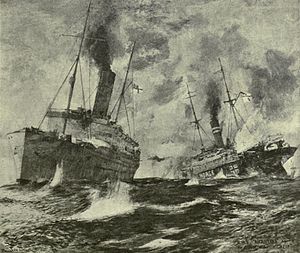
Armed merchantman is a term that has come to mean a merchant ship equipped with guns, usually for defensive purposes, either by design or after the fact. In the days of sail, piracy and privateers, many merchantmen would be routinely armed, especially those engaging in long distance and high value trade. The most famous of this type were the East Indiamen able to defeat regular warships in battle (see Battle of Pulo Aura).
In more modern times, auxiliary cruisers were used offensively to disrupt trade chiefly during both World War I and World War II, particularly by Germany.
East Indiamen of various European countries were heavily armed for their long journeys to the Far East. In particularly dangerous times, such as when the home countries were at war, a convoy system would be used whereby the ships were escorted by a warship. However, many East Indiamen also travelled on their own, and therefore were heavily armed in order to defend themselves against pirates and privateers. They also defended themselves against warships, scoring signal victories at the Battle of Pulo Aura and the Action of 4 August 1800. The British Royal Navy purchased several that it converted to ships of the line.